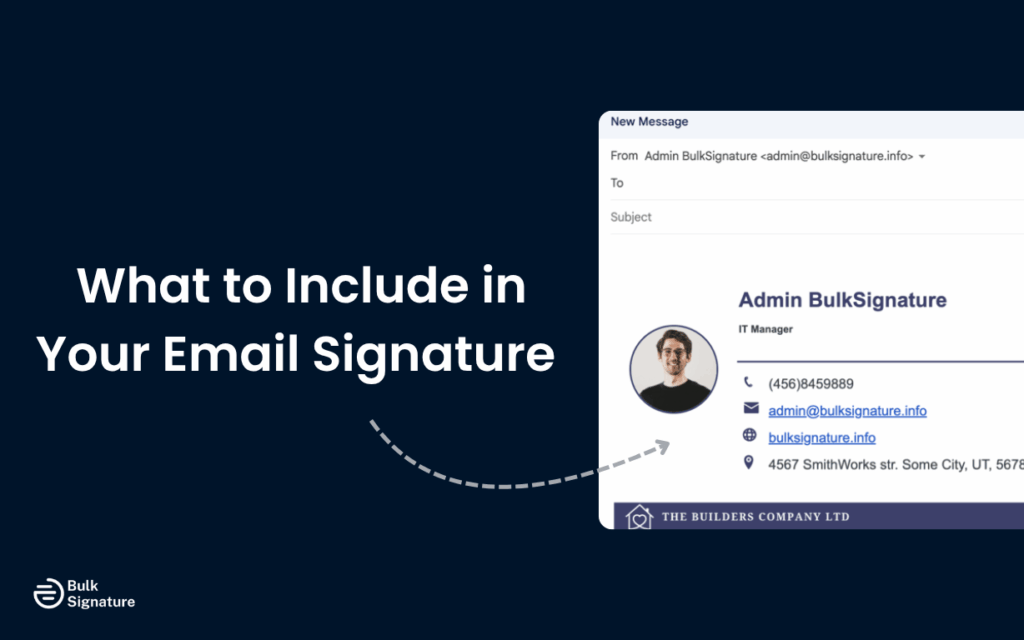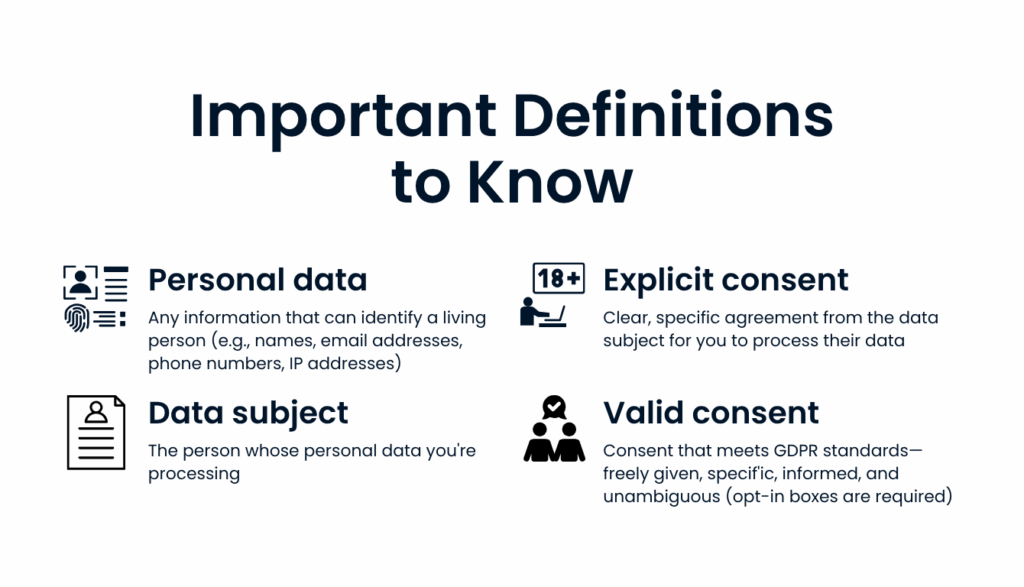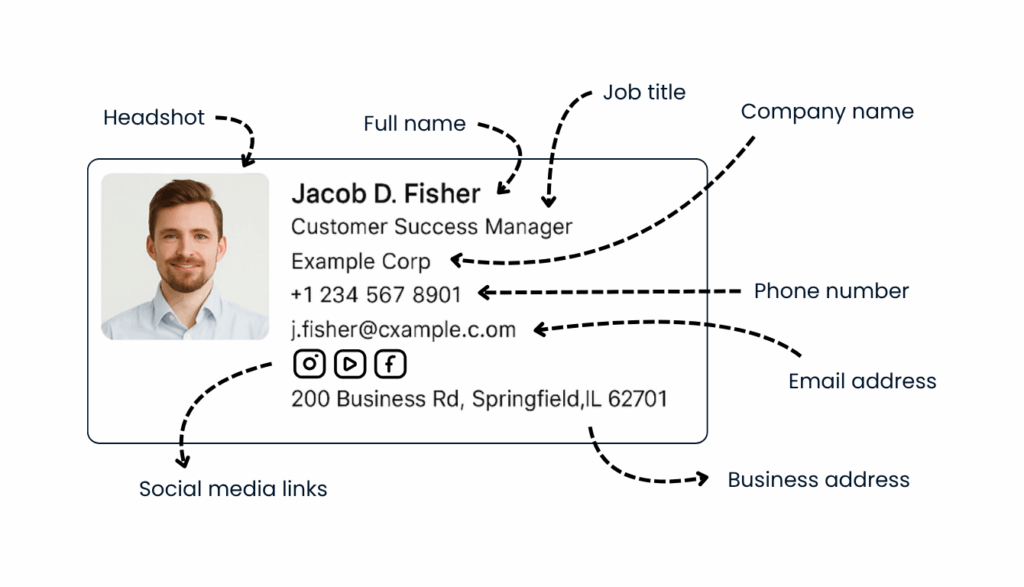
Ever wonder if your email signature could land you in hot water with applicable data privacy laws? If you’re sending marketing emails to EU citizens or handling customer data in any way, the answer might surprise you. Your email signature holds significant compliance weight that could upend your email marketing strategy.
Think about it: every email you send contains personal data, like your name, contact details, and company information. When it comes to email marketing, those signatures become part of your data processing activities. And if you’re not careful, they could put you on the wrong side of the General Data Protection Regulation, better known as the GDPR.
Why Do Email Signatures Matter for GDPR Email Compliance?
Because email signatures contain personal data and are part of data processing, they’re subject to GDPR regulations when you send marketing emails or handle consumer data.
Something most businesses miss is that email signatures are actually part of your data protection framework. Every time you send an email, you’re processing personal data.
When you’re running outbound email marketing campaigns, your signature becomes even more critical. It’s typically the first place recipients look for transparency information, unsubscribe options, and contact details. Get it wrong, and you’re potentially violating data privacy laws.
This isn’t just for EU companies, either!
GDPR applies to any business that processes the personal data of EU citizens, no matter where in the world your company is based. That means your email marketing strategies need to account for the strictest email compliance regulations, including something as simple as your signature.
Important Definitions to Know

Before we get into the weeds, let’s clarify some terms:
- Personal data: Any information that can identify a living person (e.g., names, email addresses, phone numbers, IP addresses)
- Data subject: The person whose personal data you’re processing
- Explicit consent: Clear, specific agreement from the data subject for you to process their data
- Valid consent: Consent that meets GDPR standards—freely given, specific, informed, and unambiguous (opt-in boxes are required)
What Does the GDPR Require for Email Signatures?
Under GDPR Article 6 and Recital 32, businesses must clearly identify the sender, provide contact information, explain how personal data is used, and offer recipients an easy way to manage email preferences or withdraw consent, especially in newsletters and marketing emails.
Let’s get clear on what we’re dealing with. GDPR is the European Union’s comprehensive data privacy law that went into effect in 2018. It sets strict rules for how businesses collect data, process personal data, and communicate with data subjects. In other words, it’s the ultimate do’s and don’t’s of privacy protection.
What Are the Other GDPR Rules for Emails?
Your legal basis for email marketing is another critical aspect of the GDPR to consider. You need either explicit consent from the recipient, legitimate interest (in limited cases), or another valid consent under GDPR. Your email signature plays a role in demonstrating transparency around this legal basis.
With stricter enforcement of GDPR email marketing compliance in 2024–2025, regulators are paying closer attention to how businesses handle transactional emails versus marketing messages.
How Does Personal Data in Email Signatures Impact Data Privacy?
Your email signature is packed with personal data, even if you don’t realize it. Every name, job title, phone number, and company address counts as personal data under the GDPR. When businesses collect data through email, they need to protect personal data according to legal requirements.
Common Signature Elements Considered Personal Data

Most email signatures include:
- Full name and job title
- Direct email address and phone number
- Company name and physical address
- Sometimes social media profiles or headshots
All of this information falls under GDPR’s definition of personal data. When you send marketing emails, you’re not just processing the recipient’s data. You’re also sharing your own personal data through your signature. This data collection happens every time someone saves your contact information from your signature.
Who's Responsible for Signature Data?
Under GDPR, your company is the data controller for all the personal information in your team’s email signatures. Sounds technical, but it basically means you’re on the hook for making sure that data gets handled properly, which means lawfully, transparently, and securely.
This becomes even more important if you’re using email marketing software or signature management tools. You can’t just set it and forget it. Be sure any tools you use also meet GDPR’s data security standards.
Before we get into what is and isn’t required for email signature complaints, we need to talk about different email types.
What's the Difference Between Marketing Emails and Regular Email for Existing Customers?
Marketing emails need stricter consent and compliance measures, while transactional emails (e.g., password resets, invoices) to existing customers have more flexibility under GDPR and can usually rely on legitimate interest instead of explicit consent.
The relationship between email signatures and email marketing gets trickier than most people expect. How you handle your signature really depends on what kind of email you’re sending and who you’re sending it to, such as existing customers versus potential new ones.
For existing customers, you still need to provide clear opt-out options and transparency information.
What is Legally Required in an Email Signature?
A compliant signature should include sender identification, company contact information, privacy policy links, and clear opt-out options for marketing communications. Sometimes, references to legal requirements are also needed.
Building a compliant email signature isn’t rocket science, but it does require some thought about your specific email marketing strategies and data protection needs.
Required or Recommended Elements
For most businesses conducting email marketing, a compliant GDPR email marketing signature should include:
- Your name and job title (i.e., transparency about who’s sending)
- Company name and registered address
- Clear contact information for data protection inquiries
- Link to your privacy policy
- Link to email preferences center (for marketing emails)
If you’re also subject to CAN-SPAM requirements (for US recipients), you’ll need to include your physical business address as well.
When do you need an Unsubscribe Link?
You don’t necessarily need an unsubscribe link in every email signature, but you absolutely need one in marketing communications.
For marketing emails, place your unsubscribe link prominently—either in the signature itself or in a clear footer below the signature. Make sure the process is simple and doesn’t require the recipient to log in or jump through hoops. A poorly designed opt-out process can send emails straight to the spam folder.
For transactional emails, you typically don’t need unsubscribe options since these aren’t for direct marketing purposes.
Can You Use Disclaimers Instead of Explicit Consent in Email Signatures?
No. Signature disclaimers can’t substitute for proper consent obtained through opt-in processes required before sending marketing communications. You must have unambiguous consent, which, according to Recital 32 in GDPR, means the recipient voluntarily gave consent and was informed of how their information would be used.
While signature disclaimers are helpful for setting expectations and demonstrating transparency, they’re not a replacement for obtaining explicit consent.
If you’re adding new contacts to your email marketing campaigns, you must obtain consent through proper opt-in processes, like a sign-up form with clear language about what they’re agreeing to receive, not some vague “you might hear from us sometimes” approach.
Avoiding Pre-Checked Boxes and Soft Opt-Ins
GDPR is very clear about consent quality. Pre-checked boxes are explicitly prohibited, and soft opt-in methods, like automatically adding customers to marketing lists after purchase, are generally not acceptable for direct marketing purposes. Always have an unchecked opt-in box.
Your signature can include language about your commitment to data protection, but it can’t create consent where none exists.
How Do Data Privacy Laws Impact Email Security and Signatures?
Data privacy laws require businesses to implement appropriate email security measures and include transparent information in signatures to protect personal data and maintain compliance.
While your signature shouldn’t be a legal dissertation, it can reinforce your commitment to data security and privacy.
Signature Notices About Confidentiality and Email Security
Many businesses include confidentiality notices in their signatures to show their commitment to email security. While these show your data security measures, they don’t provide legal protection if you’re not actually following proper practices.
Keep these notices brief and professional. Something like “This email and any attachments are confidential and may be subject to legal privilege” is sufficient.
Handling Breach Disclosures or Sensitive Data Mentions
Your email signature isn’t the place to discuss data breaches or sensitive consumer data processing activities. If you need to communicate about a data breach, do it through proper channels with appropriate security measures.
Supporting Data Subject Requests Through Email Signatures
Data subjects (i.e., your email recipients) have rights under GDPR, including the right to access their data, correct inaccuracies, and request email data erasure. Your signature should make it easy for people to contact you about these data subject rights.
Include clear contact information and consider adding a link to a page that explains how to make user requests about their data.
The Relationship Between GDPR and CAN-SPAM Regulations
GDPR requirements are generally stricter than CAN-SPAM, so GDPR-compliant signatures typically meet CAN-SPAM requirements too. However, there are some specific elements, like physical addresses, that may need adjustment.
If you’re sending emails to both EU citizens and US recipients, you need to comply with both GDPR and the CAN-SPAM Act. The good news is that GDPR is generally stricter, so if you’re GDPR compliant, you’re usually on the right track for CAN-SPAM compliance, too.
GDPR vs CAN-SPAM: A Quick Comparison
Requirement | GDPR | CAN-SPAM |
Consent | Explicit consent required | Opt-out acceptable |
Penalties | Up to 4% global revenue | Typically lower fines |
Scope | EU citizens anywhere | US recipients |
Unsubscribe | Must be easy and free | Must be easy and free |
Both laws require clear sender identification, honest subject lines, and easy opt-out mechanisms. Both also prohibit sending unsolicited emails to people who have already submitted opt-out requests.
It’s generally safest to follow the strictest data laws. You never know where your email list is located, and laws are constantly changing.
How Should You Manage Email Preferences and Opt-Ins?
Provide recipients control through preference centers linked from your signature, use double opt-in processes with confirmation links, and make it easy to withdraw consent at any time.
Modern email marketing is all about giving recipients personalized, supportive, and honest experiences. Your signature can support this by linking to preference management tools.
Allowing Users to Update Email Preferences
Instead of just offering an all-or-nothing unsubscribe option, try linking to an email preferences center where recipients can choose what types of marketing communications they actually want.
This approach can actually reduce opt-out requests and improve engagement with your marketing efforts. People are more likely to stay subscribed if they can customize their experience through the sign-up form preferences.
Verifying Consent with Confirmation Links
For new subscribers, use double opt-in processes with confirmation links to verify their consent. This creates a clear record of what they agreed to and reduces the risk of spam complaints while helping you collect data the right way.
Your email signature should remind recipients that they’re in control, with clear information about how to update their email preferences or opt out completely if they change their minds.
How Do You Scale GDPR Compliance Across Email Marketing Campaigns?
Use centralized signature management tools and standardized templates to maintain consistency and compliance across all team members and marketing communications. These methods also streamline updates, saving your team time.
The Benefits of Email Signature Software or Centralized Tools
Centralized email signature management tools can be a lifesaver for maintaining consistency and compliance across your organization. These tools let you create standardized signatures that include all the necessary compliance elements while keeping your brand looking professional and cohesive.
Look for solutions that let you update signatures centrally, track compliance requirements, and integrate with your existing email marketing platforms. This creates a much smoother process for managing compliance across all your marketing efforts.
When your legal team needs to update privacy policy links or add new legal requirements, centralized management means you can update everyone’s signature at once rather than chasing down individual employees to make changes manually.
Final Thoughts: Why Compliance Starts in the Signature
Besides avoiding hefty fines and penalties, a GDPR-compliant email marketing signature demonstrates your brand’s commitment to transparency, trust, and ethical communication. For companies processing personal data, it’s a low-effort, high-impact way to stay aligned with current and future data privacy laws.
When done right, your email signature becomes a compliance tool, a trust-builder, and a reflection of your company’s values. Remember, GDPR compliance isn’t just about avoiding penalties—it’s about building better relationships with your customers through transparency and respect for their privacy.
Your email signature is just one piece of that puzzle, but it’s a piece that every recipient sees. Start with your signature, then make sure your entire email marketing strategy reflects your commitment to handling personal data responsibly and giving your customers the control and transparency they deserve.
Worried about GDPR compliance across your team’s email signatures? BulkSignature helps organizations maintain compliant signatures with automatic privacy policy updates and centralized consent management. Contact our team to learn more.
Frequently Asked Questions About GDPR Email Compliance
What is GDPR data protection and how does it apply to email signatures?
GDPR data protection refers to the European Union’s General Data Protection Regulation that governs how businesses handle personal information. Your email signature contains personal data like names, phone numbers, and email addresses that must be processed lawfully and transparently.
When you include contact information in your signature, you’re processing personal information that’s subject to GDPR rules. This means you need to be transparent about how you use this information and give recipients control over their data.
How do data security requirements affect email signatures?
Data security under GDPR requires businesses to protect personal information with appropriate technical and organizational measures. Your email signature should include security disclaimers and links to your privacy policy to demonstrate your commitment to protecting recipient data.
What role does a Data Protection Officer play in email signature compliance?
A Data Protection Officer (DPO) should review your email signature standards and templates to help you remain compliant with GDPR requirements. They can provide guidance on what information to include, how to handle the data subject’s consent properly and create an efficient process for managing signatures across your team.
For larger organizations, having your DPO review signature templates helps avoid common compliance mistakes. They can also help you understand when you need explicit consent versus when you can rely on legitimate interest for existing subscribers.
How can email signatures help improve email marketing practices under the Data Protection Regulation GDPR?
Email signatures become compliance tools that demonstrate transparency and build trust with both potential customers and existing contacts. They should include unsubscribe links, privacy policy links, and clear contact information to ensure compliance with GDPR requirements.
GDPR-compliant signatures can actually improve your email deliverability and reduce bounce rates. When recipients see professional signatures with clear privacy information and easy opt-out options, they’re less likely to mark your emails as spam. This helps maintain a good sender reputation and keeps your emails landing in inboxes rather than spam folders, ultimately improving your email marketing performance.